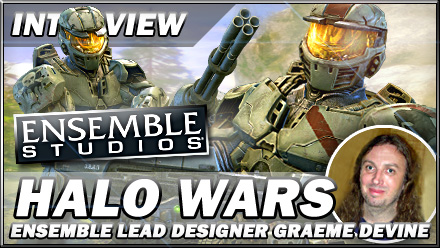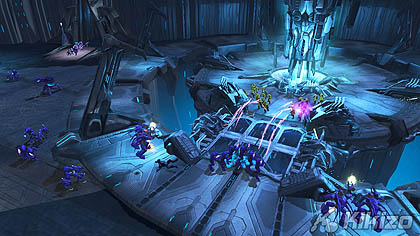Halo Wars: Ensemble Studios Interview
Extensive preview and interview with lead writer and designer at Ensemble Studios, Graeme Devine.

For poor old soon-to-be-retired Ensemble, foregrounding the "Halo" in Halo Wars has been a matter of some importance: when you're hammering together a prequel to a game of this standing, it's vital to appease the existing fanbase.
The game's lead writer and designer Graeme Devine has fallen foul of that imposing heritage more than once, as he laughingly recalls during our playtest. "We put out an X06 trailer - at the end, we gave the Spartans battle rifles. And we got nailed to the wall by fans, because they didn't get battle rifles until 2552, and oh my goodness it's 2526 and what the hell are you doing! So the fans are very aware of the story and the canon, the IP, they are extremely aware of all the events and how the events played out."
As he walks (or rather, drives) us through the introductory maps, Devine draws our attention to an abundance of carefully-nurtured parallels with the Bungie originals. Take the Warthog jeep, for instance. "Everybody knows what the Warthog looks like, sounds like, so it's very important to us to get the Warthog looking and sounding the same in Halo Wars." It handles much the same way, too, skittering and sliding across the icebound terrain like an excitable Golden Retriever.
Despite its new real-time strategy threads then, Halo Wars is, in many respects, a known quantity indeed. Ensemble has ported over a huge selection of vehicles and units from the main Halo games, including (but not limited to) Brutes, Jackals, airborne Banshees, Wraith behemoths and fragile Ghost hoverbikes on the Covenant bench, and UNSC Marines, Hornet fighters, Scorpion tanks and those hunky Spartan warriors on the human. Covenant structures still shatter in a mouth-watering rain of violet energy and molten glass, like triple-decker icing cakes under a blowtorch. Halo 3's spectacular affection for physics is here in force, though with fewer perhaps in the way of practical applications. Don't worry - you can still punt those gibbering Grunts skyward with a well-aimed Warthog.
Ensemble' audio design follows suit. Battle rifles still sound like battle rifles, plasma pistols still sound like plasma pistols: check, check, check. Composer Stephen Rippy has come up with a score heavily indebted to Bungie maestro Martin O'Donnell's soaring choral harmonies, and the voice-acting that graces the mission dialogues and blindingly polished CGI cut-scenes is as Dairylea as you'd expect.
Halo Wars takes place two decades before the events of Halo: Combat Evolved, as the forces of evolved hairless apedom (that's us) lock jaws with the motley Covenant menace for control of Harvest, a once-thriving planet now reduced to nuclear winter by years of bombardment. The Covenant don't get a campaign of their own, sadly, thanks to Levine's strict moral compass. "I like playing the good guy, that's something I always like to be. I mean, when I play Warcraft 3 I hate the fact that I turn evil halfway through the campaign." Both sides will be available in multiplayer, however.
At the outset, a legion of Covenant Elites discovers an immense Forerunner artefact buried under Harvest's irradiated ice. Reasoning that the Elites may not have humanity's best interests at heart in uncovering said artefact, the gung-ho commander of the United Nations Space Command vessel Spirit of Fire sends you to investigate, assisted by one Sergeant Forge - no relation, says Devine, to a certain Halo 3 multiplayer mode of the same name -a foxy female scientist and a "spirited" shipboard AI named Serina. "I wanted it to be a great Bruce Willis story," says Devine. "And Sergeant Forge is a great Bruce Willis character.
"Adding a new story in, especially as a prequel, is actually challenging from a canon perspective," he admits. "But because it's set twenty years back, we have enough space - it's a very different time in the actual Halo universe. It's good to be able to tell a story with a different set of characters and at a different time in the actual conflict."
Refreshingly, Devine gets more of a kick out of the Covenant backstory than he does the somewhat cookie cutter human cast. "I think if you look at it from the side of the humans, the UNSC, it's kind of boring, because we're pulling in ideas from lots of other things," he says. "But not many people look beyond that and see the aliens. I mean, these purple guys are actually pretty interesting - the fact that they all hate each other's guts, that they have no imagination whatsoever."








 Satoru Iwata Video Interview - the late Nintendo president spoke with Kikizo in 2004 as 'Nintendo Revolution' loomed.
Satoru Iwata Video Interview - the late Nintendo president spoke with Kikizo in 2004 as 'Nintendo Revolution' loomed. Kaz Hirai Video Interview - the first of Kikizo's interviews with the man who went on to become global head of Sony.
Kaz Hirai Video Interview - the first of Kikizo's interviews with the man who went on to become global head of Sony. Ed Fries Video Interview - one of Xbox's founders discusses an epic journey from Excel to Xbox.
Ed Fries Video Interview - one of Xbox's founders discusses an epic journey from Excel to Xbox. Yu Suzuki, the Kikizo Interview - we spend time with one of gaming's most revered creators.
Yu Suzuki, the Kikizo Interview - we spend time with one of gaming's most revered creators. Tetris - The Making of an Icon: Alexey Pajitnov and Henk Rogers reveal the fascinating story behind Tetris
Tetris - The Making of an Icon: Alexey Pajitnov and Henk Rogers reveal the fascinating story behind Tetris Rare founders, Chris and Tim Stamper - their only interview? Genuinely 'rare' sit down with founders of the legendary studio.
Rare founders, Chris and Tim Stamper - their only interview? Genuinely 'rare' sit down with founders of the legendary studio. The History of First-Person Shooters - a retrospective, from Maze War to Modern Warfare
The History of First-Person Shooters - a retrospective, from Maze War to Modern Warfare